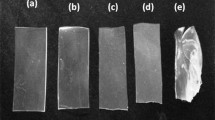Abstract
Poly(vinyl chloride)/poly(ε-caprolactone)/poly(ε-caprolactone)-b-poly(dimethylsiloxane) [PVC/PCL/(PCL-b-PDMS)] blends were prepared by solvent casting from tetrahydrofuran. The content of PVC was kept constant (60 wt%); the PCL and PCL-b-PDMS contents were varied by replacing different amounts of PCL [0–20 wt% from the PVC/PCL (60/40) blend] with PCL-b-PDMS copolymer having different molecular weights of the PCL blocks. The thermal properties of prepared blends were investigated by differential scanning calorimetry in order to analyse miscibility (through glass transition temperature) and crystallinity. Differential scanning calorimetry analyses show that the PVC/PCL/PCL-b-PDMS blends are multi-phase materials which contain a PVC plasticized with PCL phase, a block copolymer PCL-b-PDMS phase (with crystalline and amorphous PCL and PDMS domains) and a PCL phase (preponderantly crystalline).



Similar content being viewed by others
References
Andrady AL (1998) Poly(vinyl chloride). In: Mark JE (ed) Polymer data handbook. Oxford University Press, Oxford, pp 928–934
Hansen OG (1995) PVC in the health care sector, medical device technology. Octo Media Ltd, London
Nair CSB (1996) The use of PVC for critical medical applications, medical device and diagnostic industry. A Technical-Economic News Magazine for Medical Plastics and Pharmaceutical Industry, Los Angeles
Krauskopf LG (1976) Plasticizers. In: Nass LI (ed) Encyclopedia of PVC. Marcel Dekker Inc., New York and Basel, pp 505–592
Bruder A, Linder S, Mügge J, Saffert R, Spinder E (1999) PVC-material designed for medical device products. Swiss Chem 5:34
Rubin RJ, Ness PM (1989) What price progress? An upgrade on vinyl plastic bags. Transfusion 29(4):358
Rusu M, Ursu M, Rusu D (2006) Poly(vinyl chloride) and poly(ε-caprolactone) blends for medical use. J Thermoplast Compos Mater 19:173–190
Noshay A, McGrath JE (1977) Block copolymers–overview and critical survey. Academic Press, New York
Erbil HY, Yasar B, Suzer S, Baysal BM (1997) Surface characterization of the hydroxyl-terminated poly(ε-caprolactone)/poly(dimethylsiloxane) triblock copolymers by electron spectroscopy for chemical analysis and contact angle measurements. Langmuir 13:5484–5493
Yilgor I, Steckle WP Jr, Yilgor E, Freelin RG, Riffle JS (1989) Novel triblock siloxane copolymers: synthesis, characterization and their use as surface modifying additives. J Polym Sci Part A Polym Chem 27:3673–3690
Karal O, Hamurcu EE, Baysal BM (1997) Blends of polycaprolactone-poly(dimethylsiloxane)-polycaprolactone triblock copolymer with poly(vinyl chloride): preparation and characterization. Polymer 38(24):6071–6078
Gordin C, Mihai I, Rusu M, Delaite C, Salhi S (2007) Synthesis and characterization of di- and triblock copolymers based on polycaprolactone and polydimethylsioxane. Scientific Annals of “Alexandru Ioan Cuza” University of Iasi, Chemistry Section, XV 1: 67–72
Robeson LM (2004) Miscible polymer blends containing poly(vinyl chloride). J Vinyl Technol 12(2):89–94
Haiyang Y, Pingping Z, Guofeng L, Peng W, Feng R (1999) Investigations on the intrinsic viscosity of poly(vinyl chloride)(PVC) affected by polymer–polymer interactions in solution. Eur Polym J 35(2):345–353
Pingping Z, Haiyang Y, Shiqiang W (1998) Viscosity behavior of poly-ε-caprolactone (PCL)/poly(vinyl chloride) (PVC) blends in various solvents. Eur Polym J 34(1):91–94
Haiyang Y, Pingping Z, Shiqiang W, Guofeng L (1998) Viscometric study of polymer–polymer interactions in ternary systems—II. The influence of solvent. Eur Polym J 34(9):1303–1308
Iojoiu C, Hamaide T, Harabagiu V, Simionescu BC (2004) Modified poly(ε-caprolactone)s and their use for drug-encapsulating nanoparticles. J Polym Sci Part A Polym Chem 42:689–700
Garton A, Aubin M, Prud’Homme RE (1983) FTIR of polycaprolactone/poly(vinylidene chloride-co-acrylonitrile) miscible blends. J Polym Sci Polym Lett 21:45–47
Garton A, Cousin P, Prud’home RE (1983) An examination of specific interactions of esters and polyesters with chlorinated solvents by infrared and nuclear magnetic resonance spectroscopies. J Polym Sci Part B Polym Phys 21:2275–2285
Rusu M, Rusu DL (2003) Polyvinyl chloride-based blends. In: Vasile C, Kulshreshtha AK (eds) Handbook of polymer blends and composites. Rapra Technology Limited, Shawburg, pp 73–120
Karal O, Hamurcu EEG, Baysal BM (1998) Effect of a triblock PCL-PDMS-PCL copolymer on the properties of immiscible poly(vinyl chloride)/poly(2-ethylhexyl acrylate). Macromol Chem Phys 199(12):2699–2708
Elzein T, Nasser-Eddine M, Delaite C, Bistac S, Dumas P (2004) FTIR study of polycaprolactone chain organization at interfaces. J Colloid Interface Sci 273:381–387
Shih HY, Kuo WF, Pearce EM, Kwei TK (1995) ABA triblock copolymer containing two crystallizable components. Polym Adv Techn 6:413–417
Author information
Authors and Affiliations
Corresponding author
Rights and permissions
About this article
Cite this article
Gordin, C., Delaite, C., Bistac, S. et al. DSC studies of poly(vinyl chloride)/poly(ε-caprolactone)/poly(ε-caprolactone)-b-poly(dimethylsiloxane) blends. Polym. Bull. 63, 517–529 (2009). https://doi.org/10.1007/s00289-009-0101-8
Received:
Revised:
Accepted:
Published:
Issue Date:
DOI: https://doi.org/10.1007/s00289-009-0101-8




